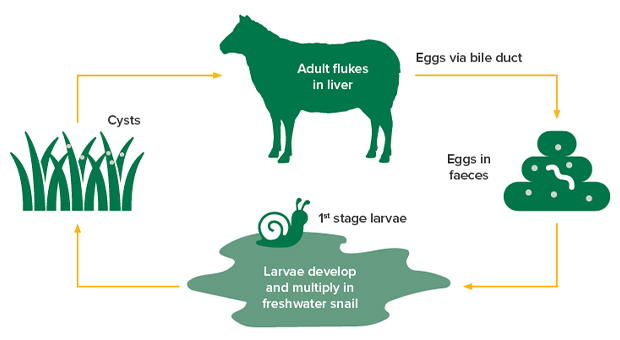Liver fluke
Liver fluke can infect cattle, sheep and goats, as well as a range of other animal species. It is a zoonotic disease which means humans can also be infected.
The lifecycle of the liver fluke requires two hosts:host (a small freshwater snail) and the definitive host (cattle, sheep, goats, alpacas, horses etc.). If the snails are not present, the liver fluke lifecycle cannot be completed as the larvae develop in the snail (for 2-3 months) before passing from the snail to form cysts which are then eaten by the livestock.

Liver fluke infection reduces animal productivity on-farm. It is also an economic cost to the meat industry due to condemnation of livers that the fluke burrow through on the way to the bile ducts.
Conditions where liver fluke is likely to occur
- where there is a suitable habitat for the snail such as springs, marshy areas, water courses, water troughs and irrigated pasture
- south-eastern Australia, especially the tablelands, coastal regions and irrigation areas of New South Wales and Victoria
- properties with a liver fluke history
- when the liver fluke snail is present on the farm. At least three species of snail, known to be intermediate hosts for liver fluke, occur in Australia. The most important is the freshwater snail, Lymnaea tomentosa
- grazing paddocks with access to the snail habitats such as springs, swampy areas, water courses and irrigated pasture.
Identification and diagnosis
Liver fluke can produce either acute or chronic disease.
Acute disease is most common in sheep and usually occurs from late summer to late autumn. Chronic disease is most common in cattle and can occur any time but is most common from autumn to spring.
Acute disease tends to follow a relatively short term intake of a massive number of fluke cysts. This causes substantial liver damage which results in:
- weight loss and general ill-thrift, leading to reduced production
- anaemia which can be seen through pale gums and membranes around the eyes. Gums and eyes may also take on a yellow hue due to jaundice
- may also be signs of abdominal pain.
The clinical signs for chronic disease develop slowly as the adult fluke accumulate in the bile ducts within the liver. Signs include:
- bottle jaw (swelling below the jaw)
- weight loss and general ill-thrift, leading to reduced production
- anaemia which can be seen through pale gums and membranes around the eyes.
Prevention
An integrated approach to liver control should consider the following:
- avoid introducing animals with liver fluke onto your property
- drench all animals that come from a liver fluke area and keep them in a quarantine paddock for a day or two
- always request an animal health statement when purchasing stock so you are aware of the disease status level of assurance that is being provided by the stock vendor
- fence 'flukey' areas to prevent access by livestock
- keep water troughs clean and free from snails
- monitor the fluke status of livestock using either faecal samples to check for fluke eggs, a blood test, or reports on liver condemnations of animals sent for slaughter
- strategic use of fluke drenches.


